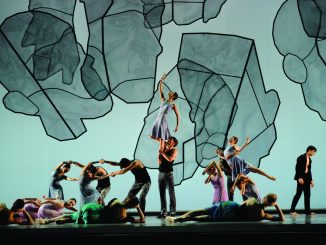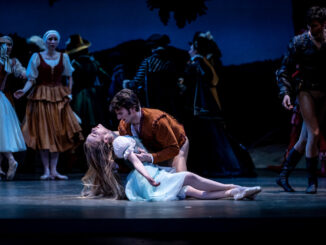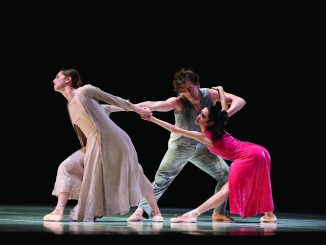
By Jack Marquez
A disclaimer: I am by no means a ballet aficionado. Prior to experiencing the San Francisco Ballet’s performance of Mere Mortals, my knowledge of the art form began with The Nutcracker and ended with the 90-second trailer to Black Swan. My expectations, then, fell somewhat along those lines–an athletic spectacle with an inoffensive orchestral score and a story that would likely jeté far over my head. I couldn’t yet say whether or not I was a “ballet guy.”
Now, though? The jury’s still out, and that’s because Mere Mortals isn’t traditional ballet. Critics, reviewers-–real journalists who didn’t need to look up the word “jeté” before writing their articles-–have called the performance “edgy,” “shocking,” and (my favorite), a “migraine-inducing digital onslaught.” Whatever this performance is, though? Sign me up for more.
Leaping dancers Cavan Conley, Esteban Hernández, and Isaac Hernández. Photo credit: Chris Hardy
I won’t spoil the plot of Mere Mortals for you, because I couldn’t tell you what it was. The program, cleverly handed out to the audience in envelopes labeled “Do Not Open,” bills the ballet as an experimental retelling of the Pandora’s Box myth from ancient Greece. In this case, the role of the titular Box goes to artificial intelligence. It’s by no means a new analogy, but it is one that’s only grown more relevant with time. Whether the ballet foretells an ending brighter than the original myth, in which Pandora unleashes all of the world’s evils upon humanity, I can’t definitively say, as I interpreted the concluding visuals of the ballet in some ways utopian and in others apocalyptic.
Soloist Wei Wang. Photo credit: Chris Hardy
That’s not really the point, though, is it? What matters is how the Mere Mortals made me feel, and I couldn’t help but marvel at how closely the feelings the performance elicited from me matched my own feelings about artificial intelligence. As a digital artist, my livelihood sits squarely in the crosshairs of advances in AI, as software tools like MidJourney and Dall-e have already begun replacing human illustrators, concept artists, and graphic designers across multiple industries. Much of the technology is a black box; our understanding of its mechanics and its ultimate potential are frighteningly limited. Because of this, I view AI with a specific blend of fear and awe, a recognition of a volatile force with the power to create and destroy. I did not expect that a ballet of all things would help me confront and articulate these feelings as effectively as Mere Mortals did.
Soloist Jennifer Stahl stands alone. Photo credit: Chris Hardy
The ensemble, directed by choreographer Azture Barton, moved among fog machines and LED video panels in an unsettling, pulsating mass. Not like the heaving breaths or regular heartbeat of a living organism, but as a kind of chaotic vibration–a mathematical simulation layered with so many tweaked parameters that the original pattern disappears. It all gave the impression of a physics experiment barely under control, with the synthesizer-backed orchestra like a powerful magnetic field buzzing under the strain of containing it. Even in their solos and duets, the dancers moved in inhuman ways. Their routines weren’t robotic–far from it–, but their transitions, while graceful, were delightfully unsettling– where I expected a knee to lead, instead, a neck. Where I expected to see a hand reach out, instead, a head. These were familiar human bodies, human faces, contorting with the unpredictability of oil spreading across a hot pan.
In keeping with the theme, massive video panels at the back of the stage displayed AI-generated images during specific scenes: Prometheus’s flames, a writhing mass of hands sprouting fingers in fractal patterns, collapsing stellar formations. Compared with the artless art gallery slideshow of the San Francisco Symphony’s opening gala from this past September, I vastly preferred Mere Mortals’ approach to the integration of AI-generated imagery. Here, these images were used simply as visual effects: computer-generated simulations that didn’t make any attempt to replicate or replace human-made art.
An especially striking animation shares the spotlight with the ensemble. Photo credit: Chris Hardy
Unfortunately, these animations did at times upstage the dancers themselves. I found my stimulus-craving millennial brain torn away from the athletic artistry on stage to watch the flashing light show on the TVs above, and I’m sure that I missed out on some wonderful moments as a result. That said, the light and dark created by the video panels combined with the dancers’ all-black bodysuits to achieve some truly magical effects, including a shocking disappearing act that became one of my favorite moments of the night. The performance felt at its strongest when the video panels played a supporting role, and undoubtedly at its weakest during an overly long video sequence toward the end, where a single dancer stood static, silhouetted against a montage of morphing clouds while the music built to a dissonant cacophony. I was one of many audience members who fell out of the show’s trance, sharing looks and even a few chuckles with our partners of “is this still happening?” Here, Mere Mortals finally felt a bit too experimental for this reviewer.
Jennifer Stahl and Parker Garrison in a duet. Photo credit: Chris Hardy
That moment notwithstanding, Floating Points’ combination electronic and orchestral soundtrack did not disappoint. At times harmonious, at times dissonant, but always compelling, the music in Mere Mortals gave the impression of a science fiction film score, a perfect fit for the show’s futuristic presentation. A presentation that, as it turns out, didn’t end with the drop of the curtains; as we filed out into the mezzanine lobby of the War Memorial Opera House, we were greeted not only by a nifty flaming “hologram” projected onto a curtain of mist, but fully-costumed performers blocking each exit out of the building, their arms outstretched in a “stay back” gesture. In a way, that last experience of stepping out of the opera house into the cold evening, squeezing past a performer in a sparkling toga, might be the best way of summarizing Mere Mortals. Was it weird? Uncomfortable? Was I not entirely sure what it was meant to represent? Absolutely.
My recommendation, then, rests on your level of tolerance for those things, because for better or for worse, Mere Mortals is confusing, confronting and unapologetically in-your-face. That’s what makes it unforgettable.
The flames of Prometheus above the ensemble. Photo credit: Chris Hardy
Following the success of its recent world premiere, San Francisco Ballet (SF Ballet) is thrilled to announce the return of Mere Mortals this spring with seven encore performances from April 18–24 at the War Memorial Opera House.




Be the first to comment